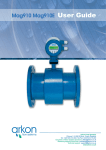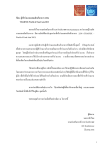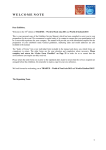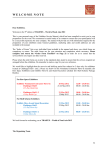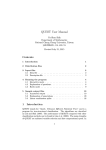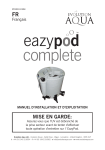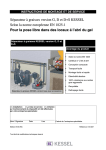Download Arkon Channelmag User's Manual
Transcript
CHANNELMAG FLOWMETERS FOR OPEN CHANNELS AND NON- FULL PIPES Instruction Manual RTM- Expolink s.r.o., Prikop 8, 60200 Brno, Czech Republic FOREWORD This instruction manual is designed to help you gain a thorough understanding of the operation of the equipment. ARKON recommends that you read this manual completely before placing the equipment in service. Although ARKON designs reliability into all equipment, there is always the possibility of a malfunction occurring. You can use this manual to help in diagnosing and repairing the malfunction, if possible. If the malfunction persists, call or write the ARKON Customer Service Department for assistance. Address and contact information: RTM- Expolink s.r.o., Prikop 8, 60200 Brno, Czech Republic Tel: +420 545 175 834. Tel/ Fax: +420 545 175 684 Email: [email protected] Website: www.arkon.co.uk For other countries, consult your nearest ARKON representative. Simple difficulties can often be diagnosed over the phone. If it is necessary to return the equipment to the factory for service, please read our terms and conditions, available on request or from our website. ARKON welcomes suggestions that would improve the information presented in this manual or enhance the operation of the equipment itself. 2 IMPORTANT – PLEASE READ DANGER The installation and operation of this product may put you at risk of serious injury or even death. Take whatever precautions are necessary to ensure your safety before making an installation or working on one. Never work alone or unsupervised. Install and operate this product in accordance with all applicable safety and health regulations, as well as any appropriate local ordinances. This product may be installed in confined spaces. Examples of confined spaces are manholes, pipelines, digesters, and storage tanks. These places can be dangerous or fatal if you are not suitably prepared. The primary hazards of confined spaces are the possibility of poisoned air and the lack of proper ventilation. Work in such places is governed by OSHA 1910.146, and may require a permit before entering. The other major hazard particular to this product is its extreme weight, which makes it dangerous to handle and creates the risk of being crushed or struck by the unit during installation. This manual may also contain Material Safety Data Sheets (MSDS) for chemical agents supplied or recommended for use with this product. If needed, these sheets will be in the MSDS Appendix. These sheets provide information about possible hazards from the chemicals. Additional MSDS, covering various proprietary agents (name-branded or trademarked mixtures) that can also be used with this product, are available from the manufacturers of those agents. This manual uses the following notations to set apart hazard warnings and notes: DANGER DANGER describes situations that will result in loss of life or serious personal injury, unless avoided. The emphasis is on clear and immediate threats to your life or safety. WARNING WARNING describes situations that could result in loss of life or serious personal injury unless avoided. The emphasis here is on the potential for a serious accident CAUTION CAUTION describes situations that may result in moderate personal injuries, property damage, or damage to the equipment, unless avoided Note NOTES draw your attention to particular features, practices, tips, or other information useful in setting up or operating the product. 3 ChannelMag Table of Contents Section 1 Introduction 1.1 Scope: ChannelMag CM2 1.2 Scope: ChannelMag PM2 1.3 Safety 66 77 88 Section 2 Installation 2.1 Media Considerations 2.2 Location and Mounting 2.3 Straight Lengths of Channel / Pipe 2.3.1 Straight Lengths of Channel (CM2) 2.3.2 Straight Lengths of Pipe (PM2) 2.3.3 Important Note 2.4 Installation, Dimensions and Approximate Weights 2.4.1 CM2 Sensors 2.4.2 Installation of 2 x CM2 ChannelMag Sensors 2.4.3 CM2/D Dimensions and Approximate Weights 2.4.4 PM2 Sensors in Full Pipes 2.4.5 PM2 Sensors in Non-Full Pipes 2.4.6 Installation of PM2 Sensors With Magnetic Enhancement Band 2.4.7 ChannelMag PM2 Enhancement Plate Expander Mechanism 2.4.8 ChannelMag PM2 Weights and Dimensions 2.5 Grounding 2.6 Cable Types 2.6.1 ChannelMag Junction Box Wiring Diagram 2.6.2 ChannelMag Entela Approval 2.7 Cable Runs From the Junction Box 9 9 10 10 10 10 10 10 11 11 11 11 13 13 14 14 15 15 16 16 1717 18 18 18 18 18 18 19 19 20 20 21 21 21 21 Section 3 Calibration Data 3.1 Calibration and Range Factors 22 22 Section 4 Maintenance 4.1 Cleaning 4.2 Zero Span Checking 4.3 Effect of Moisture Ingression 4.4 Effect of a Grounded Electrode 4.5 Effect of One CM2 of Two Inoperative 4.6 Transmitter Fault 4.7 All Checks Good, But No Signal 23 23 2323 2323 23 23 2323 2424 2424 4 Table of Contents 4.8 Erratic Signal 4.9 Signal or Indication “Swing” 24 24 24 24 Section 5 Recommended Spares 5.1 Recommended Spares 2525 5 ChannelMag Section 1 Introduction 1.1 Scope: ChannelMag CM2 The ChannelMag CM2 is suitable for open channels having diverse cross sectional shapes from 6” to 200 feet (150 mm to 60 m). They meet or exceed the requirements of ISO 9213 and are calibrated in a long open tank, believed to be the largest NIST traceable facility available. The ChannelMags are calibrated in accordance with ISO* approved methods. Each ChannelMag system is normally supplied with a NIST traceable Calibration Certificate. Magnetic enhancement plates are fixed to and calibrated with ChannelMag sensor types CM2/8” – 40”. The enhancement plates are purposely made to the required shape of the channel, to widths or diameters from 10” to 15 feet (250 mm to 3 m). Their purpose is to determine the distribution pattern of magnetic flux on calibration in ARKON test laboratory and to insure it is the same as the distribution on-site. In this way, the test calibration is the same as on-site. For channels less than 10” (250 mm) or wider than 15 feet (4500 mm), or when used with ChannelMag type CM2/D, the effectiveness of the enhancement plates is minimal, so they are not normally supplied. ChannelMag CM2 sensors generate a powerful magnetic field over the whole or significant area of the channel. They operate using Faraday’s Law, where a conductor moving in a magnetic field induces a voltage, the amplitude of which is proportional to the velocity of the conductor. The conductor is the media being measured. Large conical electrodes on the CM2 sensor measure the voltage signal, which is the mean velocity of the complete cross sectional flow and is unaffected by media viscosity or density. Volumetric flow is computed in the 4411e by multiplying level x mean velocity. The level signal from a diverse range of cross sectional shapes can be linearized in the 4411e. Level is measured normally by a high resolution ultrasonic level transducer. If the level sensor needs to be hidden from view, or if there is substantial froth on the media surface, then a high resolution pressure transducer is used under the ramps of the CM2 sensor. 6 Chanel Mag Section I Introduccion 1.2 Scope: ChannelMag PM2 The ChannelMag PM2 Series is suitable for full or partially full pipes from 20” to 120” (500 3000 mm). They meet or exceed the requirements of ISO 9213 and are calibrated in a long open tank, believed to be the largest NIST traceable facility available. ChannelMags are calibrated in accordance with ISO approved methods. Each ChannelMag system is normally supplied with a NIST traceable Calibration Certificate. Magnetic enhancement plates are fixed to and calibrated with the ChannelMag sensor(s). The enhancement plates are custom made to the required diameter of the channel. Their purpose is to determine the distribution pattern of magnetic flux on calibration in ARKON test laboratory and to insure it is the same as the distribution on-site. In this way, the test calibration is the same as onsite. The other function of the enhancement plates is to retain the ChannelMag sensors in place in the pipe. They incorporate an expander mechanism which holds the sensor(s) firmly in place, without the need of further fixtures or to cut holes in the pipe. ChannelMag sensors generate a uniquely powerful magnetic field over the whole cross sectional area of the pipe. They operate using Faraday’s Law, where a conductor moving in a magnetic field induces a voltage, the amplitude of which is proportional to the velocity of the conductor. The conductor is the media being measured. Large conical electrodes on the PM2 sensor measure the voltage signal, which is the mean velocity “weighted” to account for the complete cross sectional velocity profile. The signal is unaffected by media viscosity or density. Volumetric flow in partially filled pipes is computed in the 4411e by multiplying level x mean velocity. The level signal is linearized in the 4411e. Level is measured normally by a high resolution pressure transducer, which is used under the ramps of the ChannelMag velocity sensor. This has the advantage of being supplied with the PM2 sensor as a single unit, as well as being virtually insensitive to froth on the surface of the media. However, an ultrasonic level transducer is available, which must be mounted in a suitable manhole. 7 ChannelMag Section 1 Introduction 1.3 Safety The following warnings are provided for your safety. You should read the general note regarding danger preceding this introduction, as well as these warnings when working with this equipment: DANGER Crush hazard. The flowmeters may be very heavy (net weights from 45 to 450 lb / 20 to 200 kg each). You could be crushed to death, or very seriously injured, if the flowmeter slips during installation and strikes you or falls on you. Handle with care when installing and be sure that hoisting apparatus can safely lift the total weight of the flowmeter (see Section 5.1). Use the lifting brackets provided on the sensor (see drawing in Sections 2.2 and 2.4). WARNING Before installation, make sure the operating environments of the flowmeter and ancillary equipment are consistent with appropriate national approvals such as USA UL or NEC, Canadian CSA, European CE. The installation must be carried out by qualified personnel only. Read the entire manuals before attempting to install or operate the equipment, including for ancilliary equipment. The flowmeter electronics require normal AC power supply. The flowmeter and ancillary equipment produces no electro-magnetic fields that are harmful to the environment or to personnel. They are certified as such to meet European CE requirements. 8 ChannelMag Section 2 Installation 2.1 Media Considerations The ChannelMag is suitable for such media as water, raw sewage, slurries, algae laden river water, and similar. The minimum media conductivity is 0.5 microS/cm for operation with pulsed AC transmitters. Most water based media has a conductivity of 200 – 800 microS/cm. The ChannelMag may be permanently coated with sewage grease, algae, calcium carbonate, iron oxides or similar, without affecting accuracy. No cleaning is necessary. If there is non fluidic sediment on the bed of the channel, then the ChannelMag should sit on the channel bed with its upper-most surface above the channel bed. Ramps are then required (see Section 2.2). All PM2 ChannelMag sensors are supplied with ramps. Check the compatibility of the media with the wetted parts before installing. With some media its consistency and operational temperature range can affect this compatibility. Make sure the pressure of the media acting on the sensor(s) and the operational temperature does not exceed that specified. 2.1 Location and Mounting For lifting the ChannelMag sensor, use the lifting brackets fixed to the sensor, as shown on the drawing in Section 2.4. Use a min. diameter 1/8” (3mm) steel rope looped through the bracket holes for installing the ChannelMag sensors(s). Use the holes in the magnetic enhancement plates ONLY for convenience of removing the sensors from flowing media, since in so doing the enhancement plates may be damaged. The ChannelMag is highly insensitive to environmental electrical noise, including interference from radio and variable frequency drives. However, it is good practice to locate the ChannelMag and ancillary equipment away from the immediate area of such noisy environments. The ancillary electronics must be located remotely from the ChannelMag sensors. They must not be mounted under direct sunlight, or where they are subject to driving rain, where they cannot be reasonably read or serviced. For such environments they must be protected by a suitable canopy or protective housing. Avoid environments where moisture can accumulate in the electronics. A heated enclosure may be necessary to achieve this. The ChannelMag sensors are indefinitely submersible to 30 feet (10m)/ 15 psig/1 bar g. They are normally supplied with conduited cables and junction box (see data sheet in this instruction manual for details of lengths). Should the cables be extended then each cable may be spliced, soldered and all cable joint surrounded with shrink sleeves. Shielding must be extended to the same length as all other cable cores. Should a junction box be used to extend cables, it must be absolutely dry, then fi lled with potting compound. We recommend 3M “High Gel” type 4442 two part, re-enterable compound, mixed 50% / 50% . The typical drying time is 2 – 3 hours, but it never solidifies hard. A metal shield 1/16” (1-2mm) thick must be placed between 9 ChannelMag Section 2 Installation the electrode cables and the energizer coil cable within the junction box. Do not use silicone rubber (RTV) for potting, since it contains acetic acid which can corrode the junction box terminals. Make sure the serial number of the ChannelMag sensor(s) shown on the cables agrees with the serial number of the transmitter. This is particularly important when more than one ChannelMag flow system has been supplied. If a sensor and transmitter have been supplied separately, then the transmitter range factor has to be adjusted according to the sensor calibration (see transmitter instructions). Although the ChannelMag sensor is bi-directional, make sure the ChannelMag is installed in the channel with the flow direction arrow consistent with the actual flow direction of the media. If it is not, then the electrode cable terminals in the remote transmitter may be switched around (see separate transmitter instruction manual). The accuracy and flow calibration factor is identical in both directions. 2.3. Straight Lengths of Channel / Pipe 2.3.1 Straight Lengths of Channel (CM2) The CM2 ChannelMag must be installed in a channel with a minimum of 7 straight channel widths upstream and 4 straight channels downstream, as shown in the diagram below. For bi-directional use a minimum of 7 straight channel widths are required upstream and downstream. The straight lengths are measured from the end of the ramps. When ramps are not supplied (and the ChannelMag CM2 sensor(s) is inserted into a recess in the base of the channel), then the straight lengths are measured from the end of the CM2 sensor. W = channel width (not necessarily the width of the CM2 sensor)7W = upstream minimum length2W = downstream minimum length (must be 7W for bi-directional fl ow)L = overall length with or without ramps The ChannelMag and installation conforms to German DIN 19559 and German Waste Water Institute (ATV Arbeitsgruppe 1.2.5) requirements. 2.3.2 Straight Lengths of Pipe (PM2) The ideal location in the pipe is where there is a maximum straight length. The table below provides recommendations of minimum straight lengths of pipe for various pipe configurations. Shorter lengths or other configurations affect published accuracy, dependant on pipe size and velocity range. Consult ARKON or a qualified representative. Diametrically opposite sensors are either 1 pair or 2 pair. When an ultrasonic level transducer is used for partially filled pipe applications it must be located at least 8” (200 mm) before or after the ends of the ramps to avoid drops in level due to sub-critical flows, or rises in level due to super-critical flows. When the hydrostatic level transducer is employed its level sensing position is virtually at the start of the upstream ramp and avoids critical flow rises and falls. 10 ChannelMag Section 2 Installation Pipe Confi guration 90° bend upstream and downstream After a tee Upstream partially closed valve Multiple Sensors Number of Single Sensor Number of Straight Pipe Diameters D Upstream Downstream Straight Pipe Diameters D Upstream Downstream 10 D 5D 5D 2D 15 D 5D 8D 2D 25 D 5D 15 D 2D Downstream partially closed valve 8D 5D 2.3.3 Important Note Note When using an ultrasonic level transducer, or a hydrostatic level transducer in a stilling well, it must be installed at least 1 channel width before or after the ends of the ramps when the ChannelMag sensor lies on the channel bed. This avoids surface level drops directly above the sensors caused by sub-critical flows, or level rises caused by super critical flows. These critical flows are circumvented if the CM2 is let into a recess in the bed. As such, the upper surface of the CM2 sensor may be up to 1” (25mm) above the channel bed to avoid silt build-up. The ultrasonic level transducer may then be mounted directly above the CM2 sensor(s). Note the minimum dead band for the ultrasonic level transducer. When a hydrostatic level transducer is used it is normally installed in the ramp, with its sensing at the point of the ramp. This also avoids critical flow drops or rises in the media level above the ChannelMag sensor. 2.4 Installation, Dimensions and Approx. Weights 2.4.1 CM2 Sensors Nominal CM2 Width in. mm. 8.0 200 24.0 600 40.0 1000 Actual CM2 Width in. mm. 10.0 254 26.0 660 42.0 1066 L in. 40.0 60.0 80.0 mm. 1016 1520 2030 S in. 8.0 25.0 40.0 mm. 203 610 1020 R in. 14.5 18.0 20.0 mm. 370 460 510 H in. 2.50 3.12 3.50 mm. 64 80 89 M in. 6.0 12.0 24.0 mm. 152 305 610 Weight Each lb 55 186 355 kg. 25 85 165 11 ChannelMag Section 2 Installation Note The height “E” of the magnetic enhancement plates is custom made and normally extends 2” (50mm) below the top of the channel. The width W is adjustable to fit the channel width. W includes the mounting brackets. 1/4” (6.3mm) thick base plates with countersunk 1/4” screws from the bottom Note: A CM2/8” sensor is always supplied with ramps. Note Cables from each sensor are to run in separate conduits to the ChannelMag junction box situated above the level of the flowing media. The cable runs are omitted in the drawing for clarity. For Entela approval for Zone 2 or Class 1, Div. 2 areas see notes in Section 2.6.2. 12 ChannelMag Section 2 Installation 2.4.2 Installation of 2 x CM2 ChannelMag Sensors Adjust width before installation into channel 2.00” 50m Lifting brackets. Do not lift by the Actual CM2 Width enhancement plates. For CM2 sensors installed in a recess in the bed of the channel, the installation configuration remains the same. 1/4” (6.3mm) thick base plates with the recess must extend over the full channel width, countersunk 1/4” screws from the bottom Advised Width of Channel Note The height E of the magnetic enhancement plates is custom made and normally extends to 4” (100mm) nominally above the maximum level. The width W is adjustable to fi t the channel width. W includes the mounting brackets. 13 ChannelMag Section 2 Installation 2.4.3 CM2/D Dimensions and Approximate Weight The CM2/D is normally used with a FMX167 hydrostatic level transducer and installed as shown below. A 2-part re-enterable gel type 4442, manufactured by 3M Company, St. Paul, Minnesota, is normally supplied to retain the CM2/D in the hole made for it. The 2-part gel is mixed together in equal amounts. It makes approximately 1 gallon (4.5 liters) of gel, which should suffice for the installation of CM2/D. The hydrostatic level transducer must be installed in a stilling well as shown, such that the level is not affected by the impact pressure of the flowing media. The hydrostatic pressure transducer may be installed with its bottom most end above any silt build-up at the bottom of the channel by a suggested maximum of 0.5” (10mm). The FMX167 ha a sealed sensing diaphragm. Similarly to the FMX167, the CM2/D mean velocity sensor may be installed to protrude above the bottom of the channel by a suggested maximum of 0.5” (10mm), as shown in the diagram below. The CM2/8”, 24” and 40” ChannelMag sensors are normally supplied with mounting brackets at each side. The mounting brackets are placed over two clearance slots cut into the Magnetic Enhancement Plates. Base plates with fixing screws, countersunk from the bottom side are then used to secure the CM2 ChannelMag to the Magnetic Enhancement Plates. The clearance slots allow the Magnetic Enhancements Plates to be adjusted symmetrically about the exact width of the channel. The width must be adjusted and secured before installing the ChannelMag into the channel. Note For CM2 ChannelMags supplied without ramps, the CM2 must be placed in a recess that must be made in the bed of the channel. The recess depth must be such that the upper surface of the ChannelMag is not higher than a suggested ½”” (12mm) above the bed of the channel, but enough to avoid excessive silt or similar build-up. If higher than this is necessary, then the 14 ChannelMag Section 2 Installation step should be cemented with an approach angle of not more than 15 degrees. The recess must extend over the full width of the bed of the channel to accommodate the Magnetic Enhancement Plates. Note Note: CM2/8” ChannelMag sensors are normally supplied with ramps. 2.4.4 PM2 Sensors in Full Pipes ChannelMag PM Series sensors are used for full pipe flow measurement from 20” - 120” (500 - 3000 mm) diameter. For 20” - 47” (500 - 1195 mm) diameter a single sensor or double sensor is used, dependant on the number of straight lengths of pipe available. For 48” - 120” (1200 - 3000 mm) diameters either 2 sensors or 4 sensors are used, again dependant on available straight pipe lengths. The sensor(s) are attached to a stainless steel retention band designed for a specific pipe internal diameter. The retention band is equipped with an expander mechanism, which opens out against the pipe internal diameter to secure the sensors. In this way the pipe wall does not require holes or fixtures and is ideal for concrete tunnels. Full Pipes -- Single or Double Sensors 20” - 47” (500 - 1195 mm) Diameters Full Pipes -- Double or Quadruple Sensors 48” - 120” (1200 - 3000 mm) Diameters 15 ChannelMag Section 2 Installation 2.4.5 PM2 Sensors in Non-Full Pipes The ChannelMag PM Series sensors are used in partially filled pipes from 20” - 120” (500 - 3000 mm) diameter. For pipes 20” - 36” (500 - 915 mm) a single ChannelMag sensor is installed in a retention band at the bottom of a horizontal pipe. For larger pipes two sensors are used at the bottom of the pipe, with their center lines equally dispersed at 15 degrees from the pipe center. For partially filled pipes a hydrostatic level transducer is incorporated in a ramp on the upstream end of the sensor. The level transducer cable includes a “breather” tube, which is vented in the remote 4411e transmitter, or in a junction box when the cable is longer than 33 feet (10 m). The cables are run in plastic conduits to the pipe exterior. Partially Filled Pipes -- Single Sensor 20” - 36” (500 - 915 mm) Diameters Partially Filled Pipes -- Double Sensors 38” - 120” (920 - 3000 mm) Diameters 16 ChannelMag Section 2 Installation 2.4.6 Installation of PM2 Sensors With Magnetic Enhancement Band Center spacer used for compound sensor installation only Outer mounting points used without center spacer Bands joined here 17 ChannelMag Section 2 Installation 2.4.7 ChannelMag PM2 Enhancement Plate Expander Mechanism The expander mechanism incorporates 2 left- hand and right- hand threaded rods, which when turned with a wrench (spanner), secure the enhancement plates and sensor assembly firmly in pipe. Additional fixtures or holes in the pipe are unnecessary. 2.4.8 ChannelMag PM2 Weights and Dimensions 2.5 Grounding The CM2 ChannelMag is equipped with a grounding plate, normally manufactured from AISI 316 stainless steel. This makes sure there are no unequal potentials between the media and the shielding of the ChannelMag connection cables. For cable distances from the junction box to the transmitter of 100 feet (30m) further grounding requirements are not normally necessary. However, for longer cable lengths a pre-amp in the junction box is necessary. CAUTION Total cable distances of greater than 300 feet (100m) are not recommended, since it increases the possibility of unequal potentials. 18 ChannelMag Section 2 Installation 2.6 Cable Types ChannelMags are connected to a junction box normally using cables in flexible 1” (25mm) conduit. See the ChannelMag Sensor Specification for the standard cable and conduit lengths. The cables and conduit are stowed for packing against the side of the Magnetic Enhancement Plates and are marked “coils,” “electrodes,” and “reference.” The cables from the junction box to the transmitter are without conduits and connected to the remote transmitter terminals as follows (see separate instructions for the transmitter): Exciter Coils Black to 4 White to 5 Shield to 6 Electrodes Black to 24 White to 25 Shield to 26 Reference Coils Black to 31 White to 32 Shield to 19 The junction box is submersible and is potted with a re-enterable gel, but is not intended to be installed in the media flowing in the channel. Cables from dual sensors are wired in the junction box as shown below in Section 2.6.2. 19 ChannelMag Section 2 Installation 2.6.1 ChannelMag Junction Box Wiring Diagram BLACK RED OR CLEAR SHIELD ChannelMag Section 2 Installation CAUTION 20 The cable ends and the junction box supplied for multi-Channel Mag systems are to NEMA 6 and IP68 for permanent submersion to 30 feet (10m) water column. As such, the cable ends are supplied with shrink-fit sleeves. It is important not to cut these sleeves off during storage, as they prevent moisture permeating the cables ends. Moisture in the cables causes signal instability. Cut the sleeves off only prior to wiring into the transmitter. Cables must be split not more than 1” (25mm) from the terminal entries of the transmitter. Do not coil excess cable to avoid false inductance. 2.6.2 ChannelMag Entela Approval ChannelMags are Entela Approved For Class 1, Div. 2 or European Zone 2 Areas: 1. 2. 3. For a single ChannelMag sensor or remote junction box for use with multiple ChannelMags sensors used in applications Entela approved to CSA and NEC standards for Class 1, Division 2 areas, or the European ATEX Zone 2 areas, the remote 4411e transmitter must be used in the safe area. It is a requirement of approval for CSA and NEC that cables must run in conduits for the connection of the ChannelMag sensor(s) to the transmitter. Conduit connectors are provided for this. For ATEX Zone 2 requirements conduit is not necessary. For a single ChannelMag sensor or remote junction box for use with multiple ChannelMag sensors that are Entela approved to ATEX Zone 2 standards, it is conditional that the reference coil, exciter coil and electrode cables emanate from 3 separate cable glands. Alternatively, the reference coil and exciter coil may run in a 4-core cable, consisting of 2 x 2 core, each pair individually shielded and where the 2 core shielded electrodes cable is separated from it. All such cables must be IEC approved and is normally supplied by ARKON. The IEC cables may have identification other than black and white, but they will be clearly labeled. All ChannelMags and junction boxes must be potted with 3M re-enterable gel type 4442 or type 8882. This is normally supplied with a junction box for each system. Dual ChannelMag sensors are normally supplied with a remote dual entry junction box and is wired as shown below. For single sensor ChannelMags Sensor 2 on the diagram is omitted. 2.7 Cable Runs From The Junction Box Cables running greater than 30 feet (10m) after the junction box to the transmitter must have the electrode pair cable separated from the exciter coil pair cable by a minimum of 2 feet (0.5m). The reference coil pair cable may be run in the same conduit as the electrode pair cable. The maximum cable length is limited to 300 feet (100m). See Section 2.5. 21 ChannelMag Section 2 Installation For multiple ChannelMag systems, the electrode and reference cables may all run in the same conduit to their respective transmitters, but separated from the exciter coil cables by a minimum of 2 feet (0.5m). Multi-exciter coil cables may all run together in a single conduit, even with other power cables. Again, the multi-exciter coil cables must be separated from the reference and electrode cables by a minimum of 2 feet (0.5m). 3.1 Calibration and Range Factors The calibration data is provided on the NIST traceable Calibration Certificate, as well as on a label inside the 4411e transmitter. Details of adjustments in a fl ow range are provided in the 4411e instruction manual. 22 ChannelMag Section 4 Maintenance 4.1 Cleaning Under typical operating conditions the ChannelMag sensor requires no maintenance. Due to the uniquely high signal to media noise ratio, the affects of such coatings as algae, sewage grease, calcium carbonate, iron oxides or similar coatings have no affect on published accuracy. As such cleaning of coatings is normally unnecessary. Should there be silt or similar non-fluidic build up, the upper surface of the ChannelMag sensor must be cleaned. However, with the ramp construction the upper surface it is highly unlikely to become covered with silt or similar. When the CM2 is in a recess in the bed of the channel, it is recommended to have its upper surface slightly above the bed of the channel, but not more than ½” (12mm). This avoids excessive silt or similar build up, as well as avoiding too much turbulence due to the step from the bed to the upper surface. If more than ½” (12mm) is required, then the step to the upper surface should have suitable grouting at an angle of less than 15 º. 4.2 Zero Span Checking With the ChannelMag sensor connected to the 4411e transmitter, check for zero and span in accordance with the 4411e Instruction Manual. This confirms the electrical function of the transmitter. Note: Bad grounding will not affect the electrical zero and span test. 4.3 Effect of Moisture Ingression The exciter coils of the ChannelMag sensor should be checked at the transmitter end. Remove from terminals 4, 5 and shield 6. There should be a minimum 10Meg Ohms (typically > 20Meg Ohms) between 4 and 6 and 5 and 6 respectively. If there is less than 10Meg Ohms, moisture has probably leaked into the sensor and /or the cable, resulting in signal instability. The cable should be inspected for damage or dried out or cut away where any moisture may be. If the sensor has leakage it must be returned to ARKON or approved representative. 4.4 Effect of a To check if there is electrical ground at the electrodes, the cable ends 24 and shield and 25 and shield respectively are removed from the terminals of the transmitter. The resistances should approximately the same between each and between 100k Ohms to 5 M Ohms. If any electrode is grounded the signal will be at approximately ¾ of the normal signal. Remove anything highly conductive between the appropriate electrode and ground. Grounded Electrode 4.5 Effect of One Sensor If there are two ChannelMag sensors used as one flow system in a channel, the electrodes and coils Of Two Inoperative are wired in parallel. Should one sensor coil become defective, then the system will continue to operate, but there will be a small inaccuracy due to operating with only one sensor. If this is unacceptable a replacement sensor can be installed at a convenient time. The erroneous sensor can be determined by checking as above in the junction box. 23 ChannelMag Section 4 Maintenance 4.6 Transmitter Fault Should the resistances referenced above be correct, but the zero and span cannot be achieved, then the fault lies with the transmitter. 4.7 All Checks Good, But No Signal Check wiring in transmitter terminals in accordance with the transmitter instructions. Make sure there is actually flow through the channel. 4.8 Erratic Signal Check the following: a) Make sure the ChannelMag sensor is fully covered with media. b) Check Paragraphs 4.1.4 to 4.1.6 c) Check if the ChannelMag sensor is correctly grounded (see Section 2.5) d) Check for loose wiring. e) Make sure cables are not too long. For multiple ChannelMag systems make sure electrode cables are separated from other cables (see Section 2.7) f) The ChannelMag has high insensitivity to radios and variable frequency drives. If these are in close proximity to the transmitter or sensor then cable lengths should be kept to an absolute minimum. 4.9 Signal Or Indication Check the following: a) Make sure there is enough straight length of channel (see Section 2.3). If the requisite “Swing” straight lengths are not available, then the “damping” in the transmitter must be maximized (see transmitter Instruction Manual). b) Make sure there are no flow pipes or channels entering the channel in the location of the ChannelMag sensor . c) Make sure there is no debris or loose cables in the vicinity of the electrodes. 24 ChannelMag Section 5 Recommended Spares 5.1 Recommended Spares Since the ChannelMag sensor is a solid state sensor, completely encapsulated, there are no recommended spares. Make sure when ordering a new ChannelMag sensor or transmitter that the serial number found on the transmitter label is advised. When a new ChannelMag sensor is provided it has a new Calibration Certificate. Make sure the new calibration factor is entered into the transmitter in accordance with the appropriate transmitter Instruction Manual. 25



























